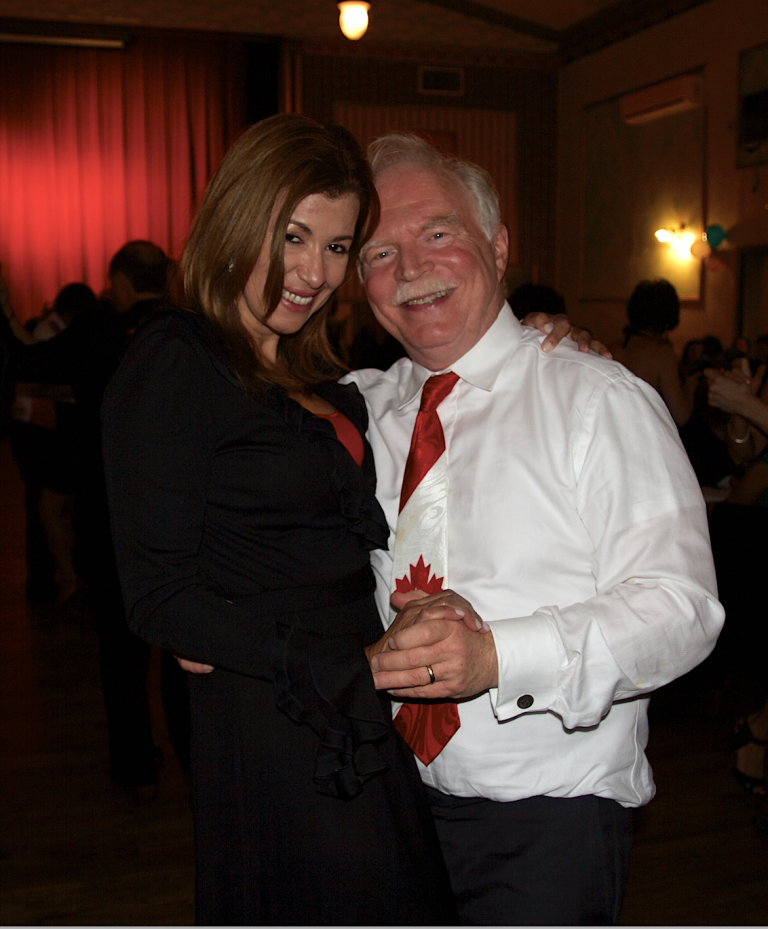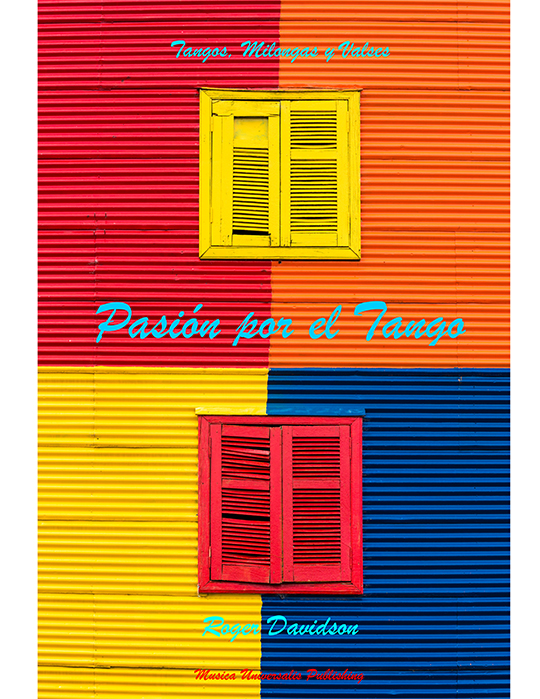INTRODUCTION
by James Gavin
The word “tango” evokes a fiery set of sights, sounds, and emotions. One’s mind flies back over a hundred years to Argentine brothels and waterfront bars, places that reeked of cigars and sweat; to couples enacting a torrid, sinewy dance of seduction—one of advancing and withdrawal, tension and release. The music, typically led by the metallic, nasal, accordion-like bandoneón, often has an undercurrent of danger. It reminds the listener of fragile, crackling old 78s played on ornate victrolas.
To many Americans, tango is an ancient relic of a far-off land. But in truth, it’s a thriving, ever-evolving tradition that has surged into almost every country in the world. Nuevo tango, the genre’s modern incarnation, teems with youthful freshness and a wide palette of musical influences.
In recent years, tango has found unexpected champions. One of them is Roger Davidson, the Paris-born, French-American, U.S.-based composer and pianist. Though principally from the classical world, Roger is a musical Renaissance man whose creative reach has circled the globe, ever in search of the commonalities that unite us all. Tirelessly prolific and versatile, he has placed a particular focus on the music of Latin America.
Roger has (so far) recorded four albums devoted to tango: Mango Tango, Amor por el Tango, Pasión por la Vida, and Te Extraño Buenos Aires. On the latter, native Argentine musicians perform Roger’s music in the nation’s capital. In all his tango writing, Roger aims to free the tango from some of its dark connotations and bring it into the sunshine. “It’s in my nature to be positive,” he says. “It’s not just the passionate nature of the tango that interests me but the forward-moving energy.”
Characteristically, he sees the music through a broad lens: “The tango is not just about romantic and sexual passion; it’s also about passion for life.”
This book, a revised and expanded edition of his 2018 tango songbook, incorporates a rush of 2025 compositions along with many others that didn’t make the first version. The spirit of his new work is the same, he says; “it’s just that my perspectives and ability to sense the mood and the vibration of the tango are more sensitive and developed now.”
Within this volume’s covers are tangos inspired by places as far apart as Budapest and Florida, Paris and Japan. There are milongas (fast tangos) and tangos written in waltz time, one of the dance’s trademark meters. Whatever the style, all of Roger’s work is based on melody, which flows from his fingers endlessly.
Tango, he says, “has always been in my ear.” He discovered it as a child when he heard a cache of recordings that his grandfather had acquired in France. “He had the first tango record I ever heard, by Jo Basile, a French accordionist and tango musician. After that I discovered old Argentine recordings.” As he watched his grandfather take tango lessons, Roger was captivated. In the course of his worldwide studies as a composer and musician, he set out on a journey to understand the workings of the tango.
Roger spent over twenty years competing in ballroom dancing, including tango, which, he learned, “is danced with both a strict and a flexible rhythm.” His first compositions in that genre date from the ‘80s. Subsequently he collaborated with two tango authorities: Pablo Aslan, the Argentine-born bassist and bandleader; and Raúl Jaurena, one of the greatest contemporary players of the bandoneón. “Raúl taught me a lot about how to play the piano and the approach to arranging tangos,” Roger says. Jaurena went on to co-arrange Pasión por la Vida, his and Roger’s duo
album, released in 2009.
That year the two men performed together at the prestigious Festival Mundial de Tango (World Festival of Tango) in Buenos Aires. As one of the only
Americans invited, Roger played a concert of his tangos with Jaurena. A few years later, they appeared together at the Argentine Consulate in New York. “Some Argentines came up to me and asked what part of Argentina I’m from,” Roger recalls. “I said, ‘Thank you for the compliment. I’m glad I’ve done something right!’” Jaurena died in 2021; Roger dedicates this collection to him.
Many of the tangos in this book reach beyond love as a subject. “No Importa” (It Doesn’t Matter) urges us “to enjoy life,” he notes, “and not get stressed out over little things that really aren’t important.” A distinct rhythmic structure and sense of form define “Fuerza Milonguera,” whose title “means the strength of the tango dancer,” explains Roger. “It’s meant to convey a sense of strength and power that’s basic to the tango.” The languid “Sol de la Tarde” (Afternoon Sun) is in ¾ time, a meter used a lot in the genre. “It’s a meditative tango with a lot of passion as well. It’s about the warmth of the sun.” Roger takes us to the opposite extreme in “El Tren que Baila” (The Train That Dances), which captures the urgency and speed of a train, its furious race to the finish; Roger’s composing captures an exciting sense of forward momentum.
“Tango Espeluzante” can be translated as “Spooky Tango.” Roger calls it “a very kinetic, energetic one. It’s not in the least bit romantic.” Yet love is far from overlooked in this collection. So much of his current music is inspired by Roger’s wife since 2014, Nilcelia, who was born in Brazil. “Mi Pasión” teems with smoldering though quiet passion, conveyed in a winding tune that goes to unexpected places. He wrote the lilting “Valentine’s Waltz” for her on Valentine’s Day of 2015.
Other selections fuse tango with the music of other cultures—an approach Roger loves to take in almost anything he composes. “Scallywag’s Tango” is a whimsical combination of tango and ragtime, while “Tango Ruso” bears the influence of songs he heard as a child from his Russian step-grandmother. “Tango de Budapest” stems from Roger’s fascination with Hungarian music, be it gypsy tunes or Bartok. “Canción de la Montaña,” he notes, “is not a typical tango; to me it sounds like a folk song from South America, from the Andes Mountains. It was inspired by folk music from that part of the world, including Argentina.”
The milonga is a double-time species of tango; here, too, Roger finds ways to stretch its definition. “Milonga del Norte,” he observes, “sounds more like a folk song from Europe than it does from Argentina.” “Milonga Austriaca” contains echoes of Austrian folk music. “I am very Germanic myself because most of my blood is from the German areas,” he notes.
Titles that seem mournful—“Perdida” (Lost), “Tango Triste” (Sad Tango)—convey his trademark hopefulness—“the optimism that you’re going to find your way out of the sadness.” He expresses the same philosophy in “Adios Dolor”—“a song I wrote about letting go of everything that caused me pain in the past”—and “Puente a la Esperanza” (Bridge to Hope). “The entire tune feels like one long phrase, like a bridge. I believe that there is always a bridge to hope.”
The tango’s future, he feels, is just as certain. Certainly its reputation as a male-female dance has broadened. Today, observes Roger, “the kinetic passion of tango has all kinds of permutations—two males, two females, or groups. Tango music, I think, is suitable for any combination of dancers.”
It also reveals a lot about the country where its fame originated. “When you’re in Argentina you understand the spirit of where the tango comes from,” Roger says. “It’s in the air. When I was in Buenos Aires I went to a lot of tango concerts. All the halls were packed. Some of the audiences sang along with tunes they knew. I’ve seen that same level of enthusiasm in New York and Paris and other places where the tango is loved.” This songbook will help keep the excitement growing.
—James Gavin, New York City, 2025
James Gavin’s books include biographies of Peggy Lee, Chet Baker, and Lena
Horne; he is a two-time recipient of ASCAP’s Deems Taylor-Virgil Thomson Award
for excellence in music journalism.
VIDEO LINKS
TANGO TRISTE
https://www.youtube.com/watch?v=JXNNSahjmUU (live)
https://www.youtube.com/watch?v=BbJjKr9UOnU
MELANCOLIA
https://www.youtube.com/watch?v=uOBshj3_MZA
FIN DE SEMANA
https://www.youtube.com/watch?v=aIfCoNN15NY
MILONGA DEL SUR
https://www.youtube.com/watch?v=9zYT9WCzUlE
MILONGA DEL NORTE
https://www.youtube.com/watch?v=e7bflpBzFug (album)
FUERZA MILONGUERA
https://www.youtube.com/watch?v=O5hY8eIAJhQ (album, RD)
https://www.youtube.com/watch?v=YjG6l-sQjF0
QUE PASARA / AYER (album, RJ)
https://www.youtube.com/watch?v=nKPWZLj5fDc (album, RD)
https://www.youtube.com/watch?v=ViDfDpb1M1I (album, RJ)
O TE QUIERO
https://www.youtube.com/watch?v=Wou6aJglxDk
BUENOS DIAS
https://www.youtube.com/watch?v=eR29BfGFMlk
TANGO RUSO. (replaces “Russian Tango” in first version of the book)
https://www.youtube.com/watch?v=GkYFVqZYiFc
VALS PARA MANANA
https://www.youtube.com/watch?v=xKslzqvSsBI
TRISTEZA
https://www.youtube.com/watch?v=jw1dc_03ygM
PARA ESTE DIA
https://www.youtube.com/watch?v=r86pR9dSCXQ
OPTIMISTA
https://www.youtube.com/watch?v=IcE1mY6rQCA
AGENTE SECRETO
https://www.youtube.com/watch?v=BGOGE13OJlU
PERDIDA
https://www.youtube.com/watch?v=X0r77YFbwOc
NO IMPORTA
https://www.youtube.com/watch?v=uAAKwlB4nSI
TE EXTRANO BUENOS AIRES
https://www.youtube.com/watch?v=6S0IWcs9aXM (album, Te Extraño Buenos Aires)
https://www.youtube.com/watch?v=DktcyKq9R_M (album, Contrabajo)
CAMINO AL SOL
https://www.youtube.com/watch?v=6pE6rLn27ag
SI LOIN DE TOI (Tan Lejos de Ti)
https://www.youtube.com/watch?v=_2hjykv-2wo
ALICIA
https://www.youtube.com/watch?v=Qmvgv9Zpotc
TODO EL TIEMPO
https://www.youtube.com/watch?v=66GZNGUeyrg
VOLVERÉ
https://www.youtube.com/watch?v=adW1nheAFoE (live)
https://www.youtube.com/watch?v=1slVl3SDgN4 (album)
SU PASIÓN
https://www.youtube.com/watch?v=YpYGtSx9MIs
PUENTE A LA ESPERANZA
https://www.youtube.com/watch?v=YhGP8NQWJbM
CANCION DE LA MONTANA
https://www.youtube.com/watch?v=hM8E3Eusrcw
LOVE FOREVER
https://www.youtube.com/watch?v=97AlfBfI5TE
QUIEN ES MI AMOR
https://www.youtube.com/watch?v=Z7ZIWSUTPKA
ALMA APASIONADA
https://www.youtube.com/watch?v=uhZVtJ2zjJA
AVENTURA
https://www.youtube.com/watch?v=a3Sbiu4J8AY
ORQUESTA DE PUEBLO
https://www.youtube.com/watch?v=rddtVgRgn0k
TANGO DEL SOL (formerly “Tango Para Ella”)
https://www.youtube.com/watch?v=KD65QLxyT68
TARDE SOLEADA
https://www.youtube.com/watch?v=YW0mNmEv2k0
RECUERDO (recorded as “Recuerdo de un amor”)
https://www.youtube.com/watch?v=OPHagRf6NKQ
ADIOS DOLOR
https://www.youtube.com/watch?v=amOzzQojDA4 (live)

